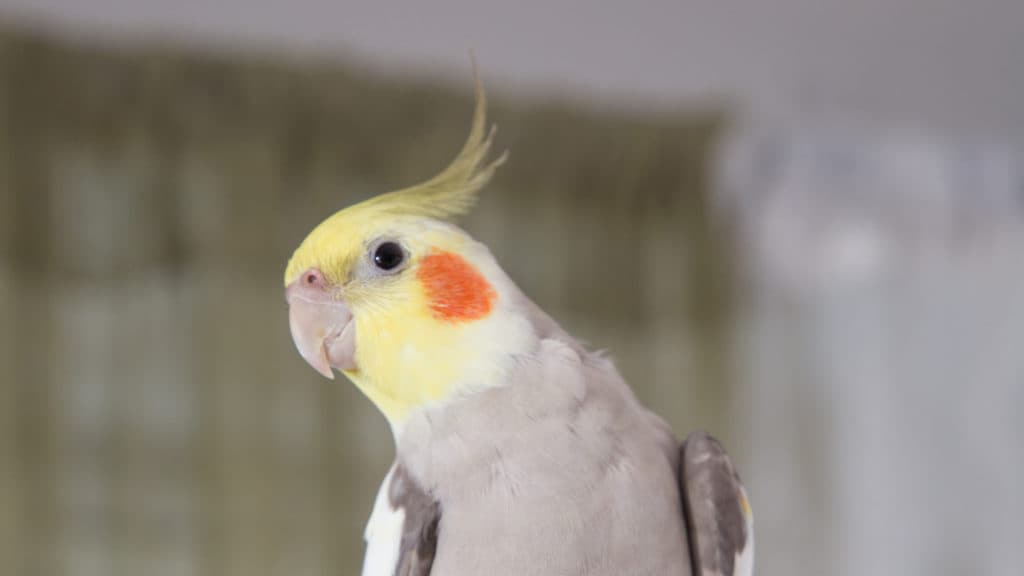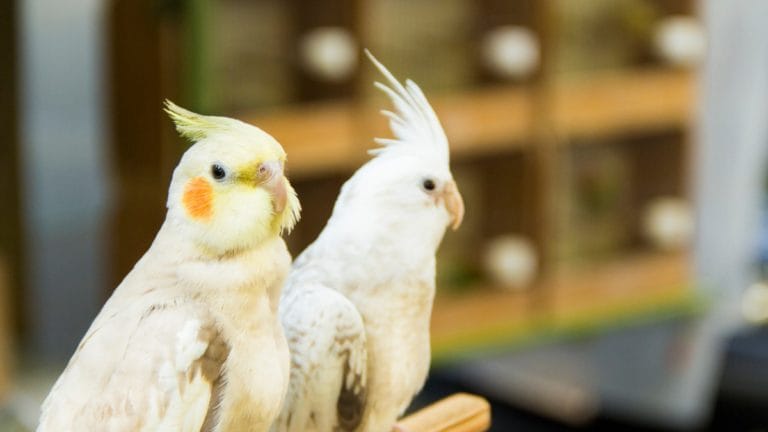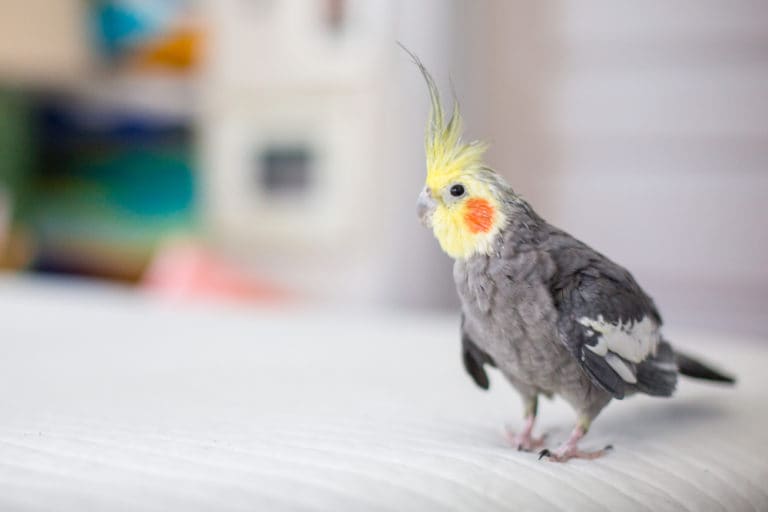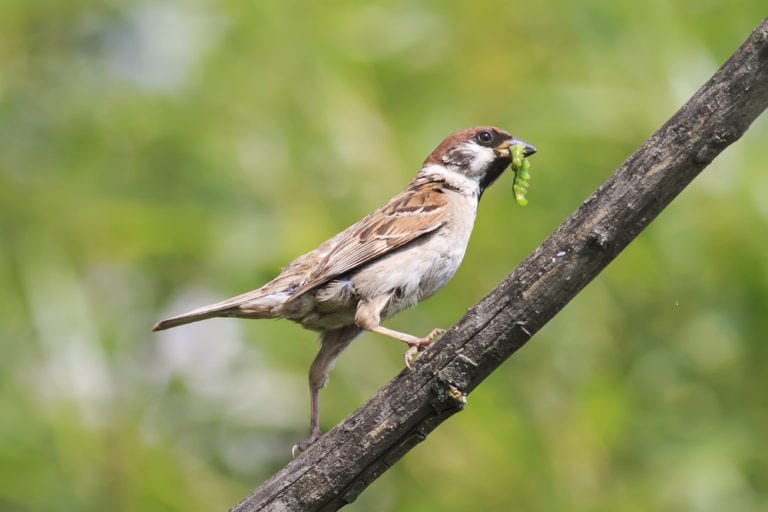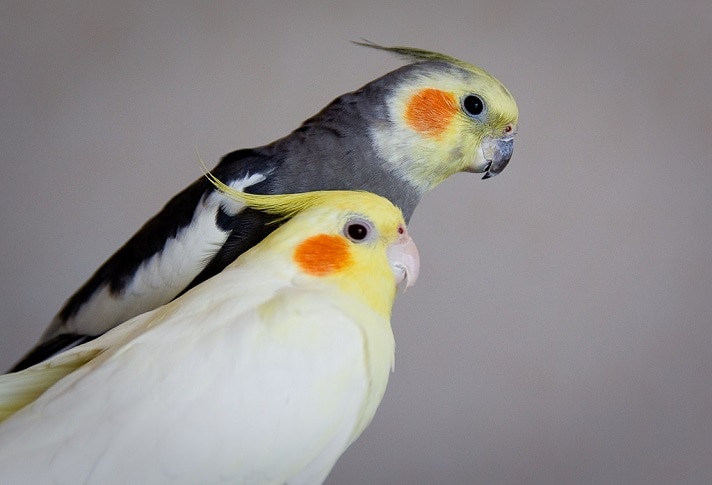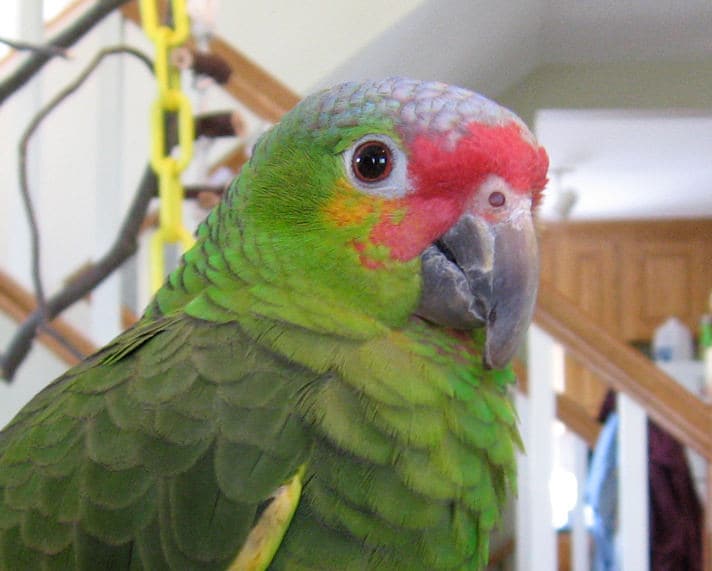1. My pet cockatiel sneezes more than my other birds; should I be concerned?
Pet cockatiel feathers make an excessive amount of powder, produced by the powder down feathers. This powder can make its way into the nares and upper respiratory tract of pet birds, including the dusty pet cockatiels that produce them. This can result in a bird sneezing to expel the excess dust, powder and dander.
As long as the sneezing is not continuous, and the sneeze is dry (it produces no moisture or mucus), it is normal. If you notice that the sneezing increases in frequency or intensity or if begins to produce mucus, then it will be time to have your pet cockatiel evaluated by your avian vet.
Consider running a good quality air filter with HEPA filtration in the bird room to clean the air of dust, debris, pollen, spores and powder down.
2. My pet cockatiel has a bald spot on the back of his head behind his crest; is this normal?
Many pet cockatiels — especially the color and pattern mutation cockatiels such as lutino, albino, fallow, cinnamon, pearl and pied, to name some – have an area behind the crest devoid of feathers.
This is not dangerous or a sign of skin disease, but it is considered a fault if showing pet cockatiels. Many responsible aviculturists attempt to produce pet cockatiels with a full head of feathers by selectively breeding their stock. Some cockatiels in the pet trade have this bald spot, however, and it may vary in size from small to a quarter-sized patch. There is no pet bird Rogaine to help them regrow feathers, so simply enjoy your pet cockatiel, bald spot and all.
3. My pet cockatiel poops in his water bowl; can this make him sick?
Many pet birds tend to poop in their water bowls, and many also dunk cockatiel bird food, including pellets, vegetables and seeds, into their water. All of these activities will cause excessive bacteria to grow in the water. Bacteria will multiply exponentially by the hour in room temperature drinking water.
For this reason, I always recommend offering pet birds water via a water bottle, a much safer way to provide a pet bird with constant clean, fresh water. Many owners worry that a pet bird won’t drink out of a bottle, but pet birds are so smart that most figure it out the first time they stick their beak in the tube and water comes out!
Until you know your pet bird drinks out of the bottle, provide a water bowl beneath it. Some water bottles are made especially for pet birds, including the large birds, so the sipper tubes are made of a strong enough metal to not bend or distort with their tremendous beak pressure.
Even though a bottle holds a lot of water, provide fresh water daily. Stale water isn’t very palatable. Some pet birds will find a way to plug up the end of the tube (pet cockatoos are particularly adept at using corn cob to obstruct the flow of water), so tap the end of the tube once in a while to ensure that the end is open. Apply a piece of tape on the outside of the bottle to mark a line in the morning to make sure that the water level drops during the day.
Factually, birds with water bowls tend to have higher levels of background bacteria in their systems than birds that drink from water bottles. Please consider converting your pet cockatiel to a water bottle and perhaps take your pet bird in for a check-up to make sure that it isn’t suffering from a subclinical bacterial infection.
4. Is a flaky beak on a cockatiel normal?
Adult pet cockatiels often have a bit of flaking on the sides of the upper beak and also a small amount on the lower beak, especially in the front portion. The beak grows continually and if your pet bird doesn’t chew up items to wear it down properly, then it may show excess flakiness from time to time.
Malnutrition and a lack of full-spectrum sunlight might contribute to beak abnormalities, including excessive flakiness. Also, slight malocclusion or trauma to the beak can result in a beak that grows abnormally, which will require professional trimming. Your avian veterinarian can properly trim away any excess beak tissue using a grinding tool, if necessary, and can instruct you regarding dietary or husbandry changes that you should make for your pet bird.
5. How do I tell if my pet cockatiel is overweight or underweight?
Whether a pet cockatiel is overweight or underweight is subjective. A normal pet cockatiel might weigh 70 grams, if it is a small-boned, short-stature bird; a long-bodied, well-muscled bird might weigh 125 grams. As a rule, if you can feel your bird’s keel bone with a good layer of muscling on either side, it is probably a good weight.
To confirm that your pet bird is of a healthy weight, ask your avian veterinarian to assess it. Write down that weight, buy a good quality gram scale and begin weighing your bird weekly. This way you will know if your pet bird is gaining weight, which can be detrimental, or losing weight, which can be a sign of illness.
6. How do I tell if my female pet cockatiel is about to lay an egg?
A female cockatiel might lay eggs even when caged without a male pet cockatiel. Several signs show whether a female cockatiel is becoming reproductively active. First, a sudden weight gain of 5 to 10 grams is often a clear sign that a hen is preparing to lay an egg. Weigh your pet bird on a weekly basis to tell whether it rapidly gains weight.
A female cockatiel that is getting ready to lay an egg will often become very cage-territorial, hissing and trying to keep hands away. She will often drink considerably more water to supply the water-rich egg albumen. Hens will often hold droppings all night and pass a large, malodorous dropping first thing in the morning. As the abdominal muscles relax from hormonal influence, the abdomen will appear a bit more rounded and soft. All of these signs will indicate that your hen is ready to lay an egg.
If you notice a firm bulge near your hen’s cloaca and she is no longer passing droppings, or if she is sitting at the bottom of bird cages, this is now a medical emergency. Seek veterinary attention as soon as possible as this might mean that she has a retained egg.
7. My pet cockatiel laid an egg. Should I leave the egg with her, or take it away? Should I take her to the vet?
If your female has successfully laid an egg, congratulations! Chances are that she will be fine.
Pet cockatiel hens are indeterminate layers; they will continue laying eggs until they have completed a clutch of eggs. It is always best to leave the egg(s) with the hen so that she thinks she has completed her cycle. If she has oviposited in a food dish, or on the bottom of the cage, leave the eggs right there.
She will usually attempt to incubate them, so if she is interested in her eggs, leave them with her. If an egg has broken, you can dispose of it. If you can acquire a similar size egg, made of alabaster, marble or ceramic, paint it white with nontoxic acrylic paint and see if your hen accepts that egg and begins sitting on it.
If she appears interested, let her sit on the egg(s) for about 20 to 21 days, the length of time for fertile cockatiel eggs to hatch successfully. I know this is inconvenient, as your hen will probably fuss at you for trying to clean her cage or feed her, but it is important.
If you remove any eggs, the female cockatiel might continue to lay them in an attempt to complete her clutch. The record in my practice is 27 eggs, and is not one that you should attempt to beat. With every egg, the female cockatiel becomes more depleted of nutrients, especially protein and calcium.
If your female cockatiel has suddenly become depressed, if she is sitting on the bottom of the cage, if her abdomen appears swollen or if you notice droppings stuck to her vent, she should be examined by your avian veterinarian in case she is having a problem with her cycle.
8. There is stuff in my pet bird’s nares. Do I need to clean it out?
When in doubt, have your avian veterinarian examine your pet cockatiel. He or she can tell you if there is a problem.
You can do the following at home to help: take your pet bird into a steamy bathroom while you or a family member showers, so that the bird’s respiratory system is kept moist. Try misting your bird with warm water several times per day.
All cockatiels have an operculum inside the nares, which is a keratinized flap. Sometimes the powder down may accumulate inside the nares, over the operculum. That’s why increased humidity will help dislodge and remove any debris.
Never stick a sharp object into pet bird nares to dislodge debris. If that is necessary, your avian veterinarian should do it.
9. Can I catch any diseases from my pet cockatiel?
The most significant disease that is often associated with the cockatiel is chlamydiosis. Chlamydophila sp. is a primitive bacterium that some pet cockatiels can carry without showing overt signs of illness. Many pet cockatiels with chlamydiosis show respiratory signs or systemic signs of illness. In some cases, chlamydiosis causes slow liver damage.
Unfortunately, it is impossible to accurately diagnose Chlamydophila in 100 percent of live bird cases. Several accurate tests exist, but pet cockatiels can keep this bacterium under the radar and veterinarians won’t always get a positive test result in an infected bird.
For families with immunocompromised members in the home, for nursing homes or for anyone with HIV or AIDS, test the pet bird and place it on a 45-day course of the antibiotic doxycycline either orally or in drinking water. This minimizes the risk of an infected bird shedding the organism into the environment, even if the bird tests negative for Chlamydophila.
Rarely, pet cockatiels carry the bacterium, Staphylococcus that can cause MRSA (methicillin resistant Staph. aureus), a potentially dangerous disease in humans and other animals. Other bacteria, such as the Salmonella group, can transmit to humans.
Pet birds, especially those with abundant powder-down like the pet cockatiel, can afflict people with a condition known as bird keeper’s lung disease (hypersensitivity pneumonitis or allergic alveolitis). This very dangerous allergic reaction in humans results from exposure to bird dust and dander. The only way to stop ongoing lung damage is by preventing exposure to birds entirely. This is often heartbreaking as it is most likely to occur in people with pet birds.
10. Should I have the wing feathers trimmed on my pet cockatiel or should I let him fly?
While I love letting birds fly for exercise and mental well-being, this is impractical in many cases. Pet birds that fly are more likely to be of a healthy weight and have fewer problems with egg-binding, but there are definite downsides.
Pet cockatiels that have regained the ability to fly often become more surly, aggressive, independent and detached, making it difficult for owners to catch a loose bird to place it back in the cage.
Flighted pet birds always risk escaping from home by mistake. An owner might answer the door with a pet bird on his or her shoulder, and the pet bird might make a break for it. Others might become frightened and fly out an open door or window.
A bird can become injured if it flies into a mirror or window. I have actually had a client’s bird fly into a window screen, punch the screen out of the frame and then fly away.
Pet birds outdoors can be prey to hawks, osprey or other hunting raptors. They may be captured by neighborhood cats or dogs. It is possible that they could fly into a body of water and drown.
Pet cockatiels are powerful fliers so you must have your pet cockatiel’s wing feathers trimmed by a person familiar with cockatiels. With most pet parrots, I clip the last five primary wing feathers all the way at the base of the feather, leaving the coverts intact. But with pet cockatiels, I often trim six or seven, test-flying the bird after removing five on each side, then removing another on each side, and test-flying again, until the bird can drift gently to the ground, not gaining any lift or traveling any distance horizontally.
The decision of whether or not to trim your pet cockatiel’s wing feathers is a personal one and should be made after discussing your home situation with your avian vet. When in doubt, have the feathers trimmed, as they will grow back within about six months.
Check your bird’s wings frequently, as once two feathers have grown in on each wing; your pet cockatiel will most likely regain flight. Many birds fly away because their owners didn’t realize that the feathers had grown back in and the bird had regained flight.
Posted by: Chewy Editorial
Featured Image: AnneJane/Shutterstock.com
Share:
